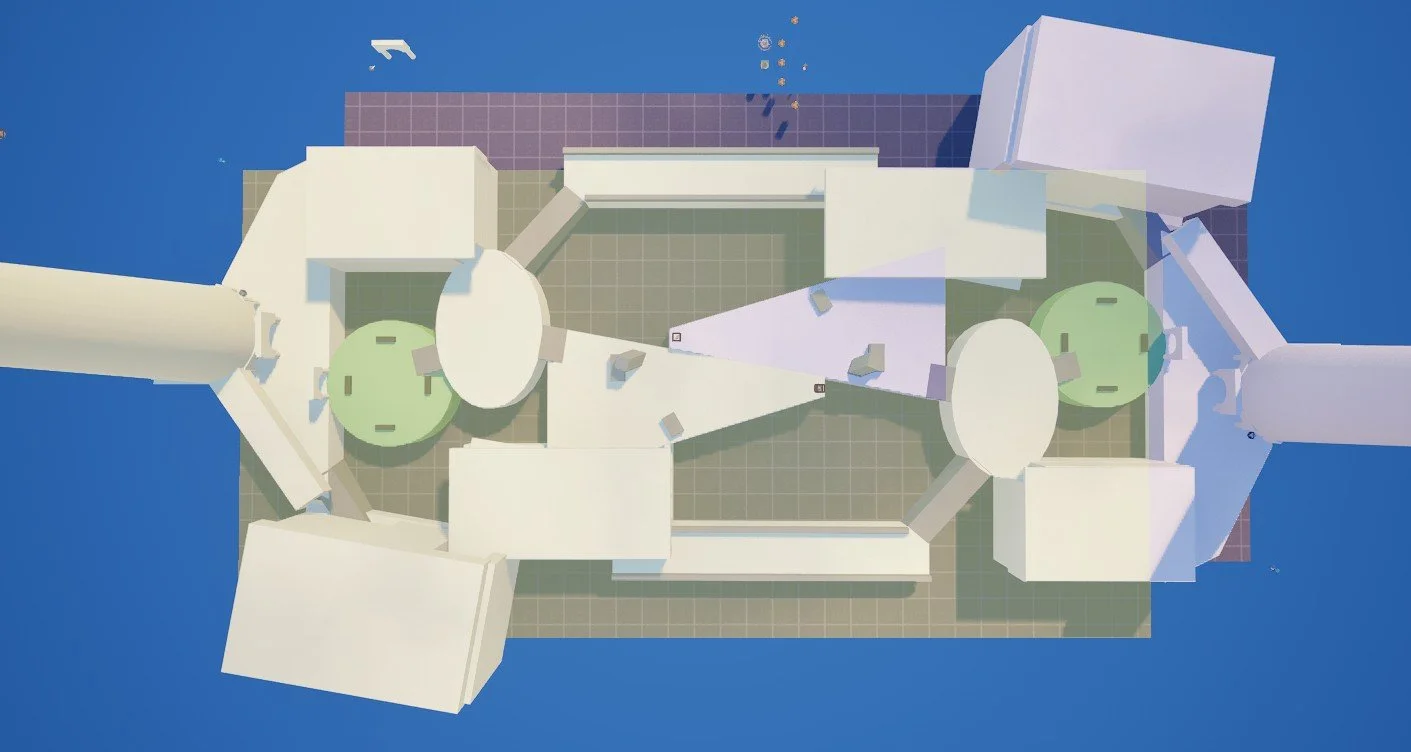Battle of Barad-dûr on Minas Tirith
In this original UEFN greybox level, I fused two iconic locations from the Lord of the Rings universe—Minas Tirith and Barad-dûr—into one intense battleground. Set in a fantasy world torn between light and darkness, players join a 3v3 capture-the-flag match that demands both teamwork and strategy. The battlefield is split down the middle: the towering spires and gloom of Barad-dûr clash with the radiant majesty of Minas Tirith. Players must shoot, flank, and defend across bridges, spires, and fortresses to control the battlefield and secure the One Ring’s fate.
Engine: Unreal Engine For Fortnite
Game Type: 3v3 Capture the Flag
Personal Project
One-person development team
Roles and Responsibilities
Level Greyboxing
Designed entire map layout using UEFN’s modeling tools
Defined engagement zones, sightlines, choke points, and traversal flow
Gameplay Systems Setup
Built 3v3 Capture the Flag logic using UEFN and Blueprints
Implemented flag pickup/drop zones, team spawns, and scoring system
Environment & Visual Design
Created mirrored bases with distinct visual language for Gondor and Mordor
Integrated key landmarks like the White Tower and Dark Tower for orientation
Combat Flow & Map Pacing
Central area: fast, high-intensity engagements
Side lanes and bases: slower, strategic combat opportunities
Item Placement & Game Balance
Placed weapons, health packs, shields, and Chug Jugs to support combat rhythm
Balanced item distribution to promote map exploration and area control
Design Documentation
Created a full Level Design Document (LDD) to define gameplay goals and structure
Included metrics, references, and feature planning to guide development
Bubble Diagram of Top Down Layout of Map
Level Design Process
Greyboxing & Blockout
Began the design by greyboxing in UEFN using built-in modeling tools to rapidly prototype layout ideas.
Started with abstract “bubble” areas to define combat zones, traversal routes, and sightlines.
Early versions used open node-based zones, but this felt unnatural during playtests—players lacked spatial anchors and flow felt disconnected.
Pivoted toward a more cohesive blockout approach where structures and forms from Barad-dûr and Minas Tirith organically merged, creating a grounded yet fantastical battleground.
Metrics-Driven Iteration
Created a detailed Level Design Document (LDD) to guide development. Included environment concepts, character/object metrics, layout diagrams, and gameplay flow.
Used player movement data (run speed, jump distance, sightlines) to define traversal paths, combat zones, and item placements.
Designed mirrored sides with different architectural styles (elegant vs. menacing) to support team identity and clarity while maintaining mechanical symmetry.
Strategically tuned travel distances between spawn, flag zones, and contested areas to keep matches engaging and balanced.
Mid-Map Redesign & Risk-Reward Spaces
After several test sessions, completely reworked the central bridge into a curved cliff area.
This change added verticality and a compelling risk-reward structure—players could climb to the high ridge for powerful gear (Rocket Launcher, Chug Jug) but faced high exposure from all sides.
Reduced cover and elevated sightlines introduced tactical decisions: risk the climb for game-changing items, or control the lower paths for safer flanks.
This central transformation became the focal point of most matches and dramatically improved player engagement.
Gameplay Element Integration
Health, shield potions, and weapons were placed to reinforce pacing and encourage movement through the map.
High-value items were positioned in exposed or difficult-to-reach spots to reward aggressive or skilled players.
Consumables near flanking lanes promoted longer pushes and counterattacks, while spawn-adjacent items gave teams tools to re-enter combat without stalling.
Playtesting & Loop Refinement
Conducted multiple rounds of internal and peer playtesting, focusing on flow, engagement hotspots, and pacing.
Made iterative tweaks to item locations, sightlines, and lane structure based on player behavior and feedback.
Refined the map over several versions, constantly improving combat readability, traversal timing, and spawn fairness.
Final result is a dense, exciting map that blends spectacle and strategy while capturing the essence of both Gondor and Mordor.
Parti Diagram of Mintis Tirith Mirrored and Rotated
This was developed to get an idea of the shapes and paths that appear when flipping and mirroring one side of the map. The left side would later be replaced with Barad-dur structures but have the same overall shapes.
Grey Boxing and Initial Planning
The level began with a greybox layout built using UEFN’s modeling tools. My initial approach followed a bubble diagram structure, outlining separate zones for combat, traversal, and objectives. While helpful for early planning, this setup felt disconnected and unnatural during playtests. Movement lacked flow, and areas didn’t blend together in a satisfying way.
To fix this, I transitioned to a more integrated design, where buildings and structures from Minas Tirith and Barad-dûr overlapped and merged. This created a more cohesive map with better flow and visual storytelling, while still preserving mechanical symmetry.
The central area also posed issues—early versions were too flat and unengaging, offering little incentive or risk. I redesigned it into curved cliffs, introducing verticality and risk-reward gameplay. Powerful items like the Rocket Launcher and Chug Jug were placed at the top, making it a high-risk, high-reward zone exposed from all angles.
Finally, the base areas were initially too open, leaving defenders vulnerable and slowing gameplay. I solved this by adding strategic obstacles that block sightlines, offer cover, and create more dynamic traversal paths, enhancing both defense and movement options.
Initial blockout version showing disconnected zones—lacked spatial cohesion and fluid player movement.
Refined greybox – overlapping architecture and layered design brought the map to life with smoother transitions and natural player paths.






